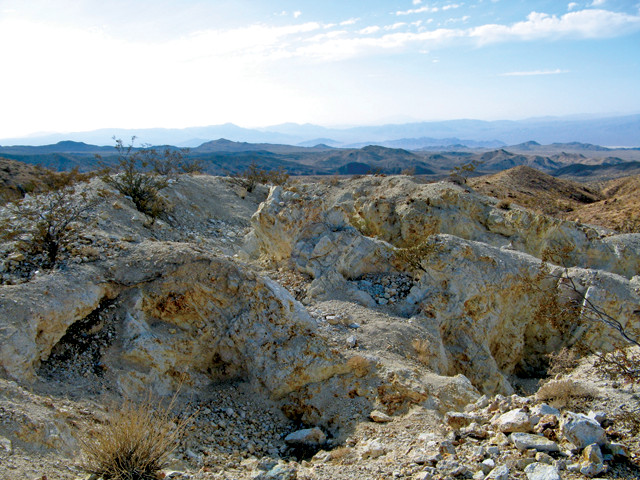
by Timothy Oleson Monday, November 2, 2015

Mines in the Halloran Hills of California's San Bernardino County were one location where researchers collected samples of turquoise to study the mineral's lead and strontium isotopic compositions. Credit: Alyson Thibodeau.
For centuries before the arrival of Europeans, turquoise was prized among pre-Hispanic cultures of North America. Caches of the distinctive, creamy-blue-green mineral have been unearthed in crypts and other ritually significant structures in what are now the southwestern United States and northern Mexico. Farther south, in Mesoamerica, archaeologists have found elaborate mosaic masks and ornamentation made of turquoise pieces. Despite multiple anthropological and historical hints, identifying where the turquoise used by different civilizations came from has proven difficult. But in a recent study, scientists have described a geochemical fingerprinting technique that may help parse the geographic origins of turquoise specimens and illuminate trade routes in ancient America.
Turquoise is a copper aluminum phosphate mineral that forms in the shallow underground from rain and groundwater that has percolated through and weathered bedrock near copper ore deposits. In addition to its main constituents, trace amounts of other elements from the bedrock, such as lead and strontium, also find their way into the turquoise, such that a given specimen’s isotopic composition “should essentially mirror … the isotopic composition of the surrounding geology,” says Alyson Thibodeau, an isotope geochemist at Dickinson College in Pennsylvania and lead author of the new study, published in the Geological Society of America Bulletin.
By examining the composition of a turquoise artifact — particularly the lead and strontium isotopes, which are powerful tracers because they vary extensively in nature — and comparing it to known geochemical signatures of the rock in and near copper deposits in the U.S. and Mexico, researchers can hopefully locate the origin of the turquoise, Thibodeau says.
To confirm that turquoise preserves isotopic signatures of its source rocks as expected, Thibodeau and her colleagues first analyzed lead and strontium isotopes in 137 pieces of turquoise with known origins in one of 19 different mining districts. Some samples were borrowed from museum collections; others were hand-collected from mining sites in Arizona, California and New Mexico. Overall, the researchers found that lead and strontium isotopic ratios in the samples varied widely, and that the samples reflected the compositions of the geologic settings in which they had formed.
“Regionally, it’s very easy to distinguish among turquoise deposits,” Thibodeau says, because there are strong patterns in the isotopes. For instance, using strontium isotopic ratios, turquoise from mining districts in the Rio Grande Rift Valley (RGRV) of Colorado and New Mexico is distinguishable from turquoise originating in Arizona and California; and using lead isotopes, specimens formed in the north of the RGRV are distinguishable from those formed farther south in the geologic province.
Thibodeau’s team further tested their technique’s utility as a fingerprinting method by analyzing the isotopes in small pieces pulled from 10 turquoise artifacts, such as beads and pendants, recovered from several ancestral Zuni archaeological sites in western New Mexico. The results suggested the raw material in the artifacts originated in the Cerrillos Hills farther east in New Mexico, an area also identified as a source of turquoise in Zuni traditional history. “The fact that the archaeological, the ethnographical and the geochemical evidence all tell us the same thing reinforces the likelihood that the source attributions that we’re making with this method are correct,” Thibodeau says.
The success of the method may open new avenues for addressing longstanding uncertainties in our understanding of pre-Hispanic cultures. Given that the major known North American turquoise mining districts are in the U.S. Southwest or northern Mexico, Thibodeau says, one of the big questions is where the Mesoamerican cultures of central or southern Mexico, like the Aztecs and the Maya, got their turquoise. Was “that actually coming from the Southwest [of the present U.S.], or was it coming from somewhere else?”
“Long-distance trade [with cultures to the north] has usually been assumed as the means by which turquoise entered Mesoamerica,” says Frances Berdan, an anthropologist and Mesoamerican specialist at California State University at San Bernardino, who was not involved with the research. Other items, such as chocolate and live scarlet macaws, are thought to have moved north in exchange, she says, but exactly how, when and even if this sort of turquoise trade occurred, aren’t entirely clear.
The new study has important implications for Mesoamerican studies, Berdan says: “If the provenance of the turquoise stones can be established, that is a critical step in understanding economic and possibly political relations across broad regions.”
© 2008-2021. All rights reserved. Any copying, redistribution or retransmission of any of the contents of this service without the expressed written permission of the American Geosciences Institute is expressly prohibited. Click here for all copyright requests.